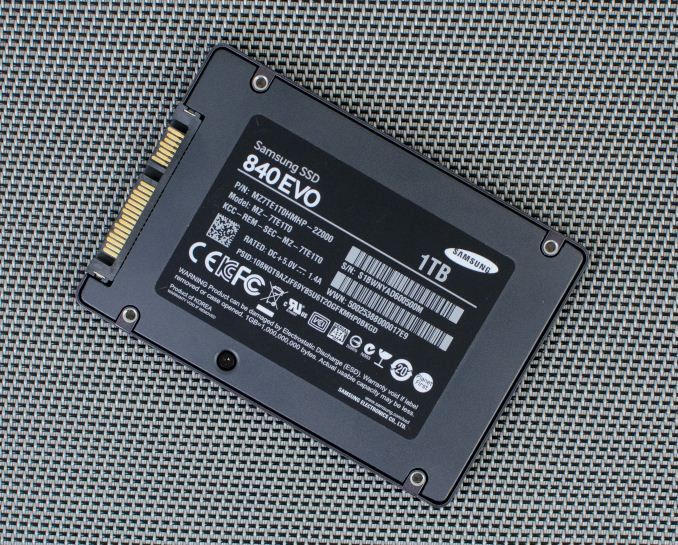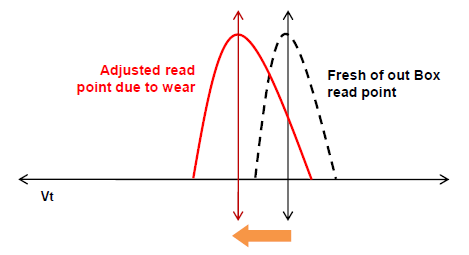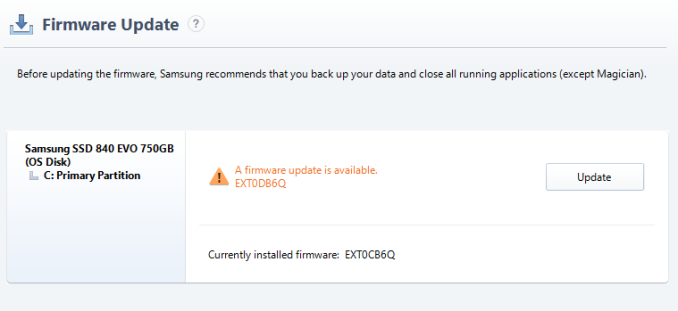Samsung Releases Second 840 EVO Performance Fix
by Ryan Smith on April 27, 2015 6:00 PM EST
If nothing else, the odyssey of Samsung’s 840 EVO has not been lacking in excitement. After initially launching in 2013 to great fanfare as an excellent, strong-performing low-cost drive, over the long run performance regressions began to occur in deployed drives that saw the read performance of old data significantly drop. At the heart of the issue was the drive’s relatively uncommon 19nm TLC NAND, which given the combination of small feature size and tighter requirements of TLC, eventually resulted in the drive having to slow down and re-read cells to properly read the charge-decayed cells.
Aiming to fix the issue, in 2014 Samsung released a performance restoration tool and firmware update for the 840 EVO. The combination of the tool and firmware would update the drive to better handle decayed cells and reduce the need to re-read them, meanwhile the restoration tool would refresh the drive’s data by re-writing all of the data to fresh cells. The idea being that fresh data in combination with the newer firmware would prevent the drive’s performance from decaying again.
Unfortunately that didn’t work out as planned, and while the data refresh from the performance restoration tool did bring drive performance back up, over the long run performance once again began decaying on old data, even with the firmware improvements. As a result Samsung has commissioned a second, more permanent fix for the 840 EVO. This fix involves another firmware update, this time installing a firmware that periodically refreshes old data rather than the one-off refresh of the performance restoration tool. Refreshing the data once again brings performance back up to where it should be, and the periodic, repeating nature of the refresh means that data is never allowed to get too old to let performance degrade again.
Ultimately Samsung’s second fix is a bit of a brute force solution to the problem, but at this point there doesn’t seem to be anything Samsung can do about 19nm TLC cell charge decay other than to refresh the data, as the problem is intrinsic to the NAND itself. Pre-release versions of the firmware show that this fix works, and conceptually this is much more likely to work over the long run than Samsung’s initial fix. The tradeoff is that it does consume P/E cycles to refresh the data, but by our own calculations even 5 years of refreshes at 1/week would only be 26% of the drive’s rated 1000 cycle lifetime. Meanwhile for the longer term, Samsung has since moved on to 3D-VNAND in newer drives, which is more stable than very small geometry planar NAND and essentially turns back the clock on NAND scaling issues. So the 840 EVO should be the last Samsung TLC drive to encounter this issue.
In any case, after previewing the updated firmware to the press, Samsung has released the updated firmware and its associated version of Samsung Magician (version 4.6) to the public over on their website. After an initial staggered release over the weekend – we suspect to make sure not too many users had the firmware if a problem quickly cropped up – Samsung looks to have opened downloads to everyone. However Mac and Linux users will want to note that at this time only the Magician version of the firmware has been released; the bootable ISOs for directly updating the drive have yet to be updated.
In the meantime this will continue to be an issue we keep an eye on. As with the initial problem and Samsung’s first fix, the decay issue only occurs after a time, so we’ll have to see where 840 EVO performance is in a couple months’ time. However with the very nature of the problem and the periodic refreshing of data, we’re hopeful that this will finally put an end to the performance degradation.
Source: Samsung












73 Comments
View All Comments
leexgx - Thursday, April 30, 2015 - link
i had over 15 MX100 never had BSOD issues (guess its some motherboards issues)serndipity - Thursday, April 30, 2015 - link
I purchased (2) 256GB MX100 drives (Fall of 2014) and always wondered why the BX100 & MX200 series came out, within 6 months of the MX100 availability. Just as Crucial finally introduced a SSD management tool (e.g. Storage Executive Client is a joke), I chose a Samsung 850 EVO for my next build. Although I knew of the 840 EVO 'old data' issue, their Magician software tool, 3D V-NAND flash memory w/ increased geometry and 5 year warranty were deciding factors.Although, fingers crossed, my MX100 installs, both in Win 7 laptops have been trouble free, I now see that others have had numerous issues with stability, power supply and NCQ trim. As a result, there has been a new firmware (MU02) release to fix these and other problems.
However, after reading of so many problems with this update within their user community, I decided not to apply the update at this time.
Achaios - Tuesday, April 28, 2015 - link
Has anyone managed to successfully update the firmware via bootable USB? i.e. copy the files from the ISO file to a bootable USB, boot from the USB and apply the firmware update?Achaios - Tuesday, April 28, 2015 - link
My PC hasn't even got a CD/DVD drive anymore. These are so 2008.Coup27 - Tuesday, April 28, 2015 - link
Clearly they aren't so 2008 because it would be very useful to you right now.I understand why you may not bother to put one in your build but it's still handy to have a USB optical drive nearby.
trparky - Tuesday, April 28, 2015 - link
Find a program called Rufus, it will allow you to make a bootable USB flash drive from the ISO file.Lothsahn - Tuesday, April 28, 2015 - link
This new firmware has serious issues with fstrim under Linux. The previous revision did not.Can we get a big disclaimer in the article and ask Samsung for a response? Do they plan to address this?
Reported here:
http://www.overclock.net/t/1507897/samsung-840-evo...
trparky - Tuesday, April 28, 2015 - link
The workaround is to not use the fstrim command and to use the discard flag in the fstab file instead.Gigaplex - Tuesday, April 28, 2015 - link
I read through the thread and they tried switching to discard instead of fstrim. They still got data corruption. It sounds like TRIM is thoroughly broken, at least on their particular drive. Hopefully it's just an isolated case of faulty hardware.Azurael - Wednesday, April 29, 2015 - link
Samsung's history with flash memory and TRIM/DISCARD is NOT good. Remember all those dead S2s, Notes, S3s, Note 2s, etc caused by their buggy eMMC firmware? I wouldn't touch a device with NAND flash which Samsung have been near with a bargepole these days.